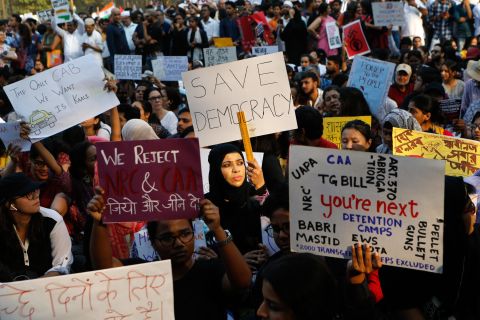Large protests have swept the country of India since early December 2019 after the Indian government, led by the Hindu nationalist Bharatiya Janata Party (BJP), enacted the Citizenship Amendment Act (CAA) on December 12, 2019.[1] Once largely peaceful protests between Muslim and Hindu groups are now violent clashes between public and private individuals living in India. On February 23, 2020, a day before President Donald Trump’s arrival, violence broke out in northeast Delhi and thirteen people were killed.[2] Within days, thirteen deaths grew to thirty-eight deaths with two hundred injured, most of whom were Muslim and many of whom suffered harm at the hands of police.[3] This week of tension and violence is described as “the worst sectarian violence the city has seen in decades” as rioters blew through majority Muslim neighborhoods.[4]
What about the CAA has caused so much unrest and violence in India?
The immigration crisis around the world has caused nationalist groups to rise in popularity, this is also true of India. India has seen a rise in right-wing ethnonationalism under the current Indian government, which it is largely controlled by the BJP, including the Prime Minister, Narendra Modi.[5] After, the BJP alleged millions of Bangledeshi Muslim migrants were living and working in India illegal, India’s democratic government has succumbed to non-secular policies.[6]
The CAA was enacted with stated purpose of “giv[ing] sanctuary to people fleeing religious persecution.”[7] The CAA amended the prior Citizenship Act of 1955 (Act) which barred all illegal migrants[8] from obtaining Indian citizenship.[9] The 2003 amendments to the Act created the statewide National Register of Citizens (NRC), which had already been in effect beginning in 1951 is Assam.[10] The NRC is a proposed list of all Indian citizens and is primarily used to identify illegal migrants.[11] Once a person is identified as an illegal migrant, that person suffers the consequences of “statelessness, deportation, or prolonged detention.”[12] The BJP, after review of the NRC, discovered many Hindus were excluded from the NRC because of the strict documentation requirements under the 2003 amendment.[13] The BJP campaigned on creating a solution to this problem and succeeded on that campaign promise when the Indian government passed the CAA.[14]
The CAA allows “any Hindu, Sikh, Buddhist, Jain, Parsi, or Christian migrant from Afghanistan, Bangladesh, or Pakistan who arrived in India on or prior to December 31, 2014” to apply for and gain Indian citizenship.[15] It provides now legal migrants protection from legal inquiries into their immigration status and lowers the residency requirement to no less than five years.[16] The CAA intentionally denies Muslims a pathway to citizenship and intentionally denies Muslims these new privileges.
Opposition groups have challenged the CAA asserting the bill violates the secular principles of India’s Constitution.[17] Section 14 states, “[t]he State shall not deny to any person equality before the law or the equal protection of the laws within the territory of India.”[18] The opposition groups argue the CAA directly conflicts with this Article because it “explicitly and blatantly seeks to enshrine religious discrimination into law, contrary to [the] long-standing, secular constitutional ethos.”[19] The effect of the CAA is to delegitimize Muslim citizenship solely based on religious beliefs.
Opposition groups also find flaws with the government’s stated reasoning and defenses for the CAA, to protect those who have suffered religious persecution without regard to India’s religious minorities.[20] By identifying select religious groups in the CAA, the CAA ignores religious persecution felt by Muslim groups in the named countries and in other neighboring countries.[21] Further, no one seeking refuge under the CAA is required to show proof of religious persecution.[22]
BJP officials and supporters defend this policy by claiming no country allows illegal migration.[23] They further explain away the disparate impact on Muslims, including those who experienced religious persecution, by asserting “the exclusion of Muslims from the ambit of the bill’s coverage flows from the obvious reality that the three countries are Islamist ones, either as stated in their own constitutions, or because of the actions of militant Islamists, who target the minorities for conversion or harassment.”[24]
Regardless of the conflicting views about the CAA, there are substantial human rights implications on Muslims living in India. In 2008, detention camps were built in Assam to address rising tension about illegal migrants living in India. In early 2018, the National Human Rights Commission of India conducted an investigation into these camps and found conditions that appeared to violate international law.[25] These conditions are a result of undefined rights for illegal migrants.[26] Illegal migrants are subject to rules at par with or lower than criminally detained persons, meaning the detainees have less rights than convicted criminals.[27] Living conditions are inadequate, detainment is indefinite, and migrants are cut off from their families.[28] Currently, the Indian government intends to build more internment camps to house Muslim “foreigners.”[29] One camp is about the size of seven soccer fields and is meant to house over 3,000 people.[30] The Indian government has shown a history of mismanaged and inhumane detainment of illegal migrants. The rising tensions give no hope that Muslim migrants placed in the new camps will experience better conditions or treatment by the government officials. International commissions are beginning to take more action to investigate the seriousness of the effects of the CAA on the Muslim community in India.[31]
- Arsalan Iftikhar, India’s New Anti-Muslim Law Shows the Broad Allure of Right-Wing Islamophobic Policies, NBC News (Jan. 13, 2020, 10:20 AM), https://www.nbcnews.com/think/opinion/india-s-new-anti-muslim-law-shows-broad-allure-right-ncna1112446. ↑
- Delhi Clashes: Thirteen Killed as Hindu and Muslim Groups Clash, BBC News (Feb. 25, 2020), https://www.bbc.com/news/world-asia-india-51612461. ↑
- Jonah Shepp, Why Was There a Wave of Violence in India While Trump Was Visiting?, NY Mag: Intelligencer (Feb. 28, 2020), https://nymag.com/intelligencer/2020/02/what-is-happening-in-india.html. ↑
- Id. ↑
- Iftikhar, supra note 1. ↑
- Id. ↑
- Citizenship Amendment Bill: India’s New ‘Anti-Muslim’ Law Explained, BBC News (Dec. 11, 2019), https://www.bbc.com/news/world-asia-india-50670393 [hereinafter Citizenship Amendment Bill]. ↑
- Illegal migrants are defined as “foreigners who entered India without valid travel documents or entered with a valid travel document but stayed beyond the permitted period.” U.S. Comm’n on Int’l Religious Freedom, Legislation Factsheet: The Citizen (Amendment) Act in India (Feb. 2020), https://www.uscirf.gov/sites/default/files/2020%20Legislation%20Factsheet%20-%20India_0.pdf [hereinafter Factsheet]. ↑
- Id. ↑
- Prabhash K. Dutta, Nationwide NRC: Why There is No Need for a New Law, India Today (Dec. 26, 2019, 1:55 PM), https://www.indiatoday.in/news-analysis/story/nationwide-nrc-why-there-is-no-need-for-a-new-law-1631620-2019-12-26. ↑
- Factsheet, supra note 8. ↑
- Id. ↑
- Id. ↑
- Id. ↑
- Id. ↑
- Id. ↑
- Citizenship Amendment Bill, supra note 7. ↑
- India Const. art. 14. ↑
- Citizenship Amendment Bill, supra note 7. ↑
- Factsheet, supra note 8. ↑
- Id. ↑
- Id. ↑
- Citizenship Amendment Bill, supra note 7. ↑
- Id. ↑
- Harsh Mander, Report on NHRC Mission to Assam’s Detention Centres from 22 to 24 January, 2018 (2018), https://drive.google.com/file/d/1skGrqF6L8XnW8nsYbw2oruAi5yKsuxUx/view. ↑
- Id. ↑
- Id. ↑
- Id. ↑
- Iftikhar, supra note 1. ↑
- Id. ↑
- Factsheet, supra note 8. ↑


